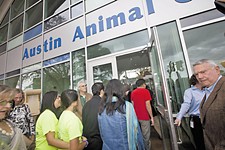Pit's End
Owners of pit bulls and similar-looking breeds face an unwelcoming rental market
By Nina Hernandez, Fri., May 6, 2016
A day inside the Austin Animal Center's intake department can be chaos. A pet owner is there to make the toughest decision – surrendering an animal. At that point, calls to friends and family members have usually been made. Pleas to a landlord to grant an exception have already fallen on deaf ears.
Behind the lobby, in a room filled with large kennels, dogs – many of them medium to large breeds – experience their first moments in this new situation. Some of them still whine when someone new approaches the gate. Last year, the shelter took in nearly 18,000 animals, 8,000 of which were dogs.
The emotional toll on the animals can be severe. Deputy Chief Animal Services Officer Kristen Auerbach credits the shelter's more than 500 volunteers for keeping them healthy. "For most people, if they imagine their own pet, and they imagine that pet in a cage for a week and how it would act when it came out," she says. "So if you take the average dog and you put it in a cage for a week and you take it out, it's going to have a lot of energy, and it's going to be bouncing up and down and jumping off the walls. Just like any pet dog at home would. And many of our dogs are here for months, so you can imagine."
Small dogs and cats move through the shelter relatively quickly, Auerbach says. It's the bigger dogs that average 60 days there. If they're one of a long list of breeds commonly banned at apartment complexes or rental properties (including pit bull terriers, Staffordshire terriers, Rottweilers, and German shepherds, among others), they may stay longer. Says Auerbach: "It impacts us because we have, at any time, 200 dogs that might be identified as pit bull dogs or restricted breeds in the shelter. There's no shortage of people who want those dogs. There are adopters coming in every day, saying, 'Oh, he's so cute, but I'm not allowed to have a pit bull.' We hear that every day, over and over again."
No Scientific Proof
The term pit bull generally refers to four breeds: American pit bull terriers, American Staffordshire terriers, Staffordshire bull terriers, and English bull terriers. Bites or attacks committed by any of these breeds routinely make headlines. The American Veterinary Medical Association crunched some numbers in their U.S. Pet Ownership & Demographics Sourcebook from 2012: 4.5 million people are bitten by dogs in the U.S. every year. Of those cases, 20% need medical attention. In two years, between 2010 and 2012, more than 350,000 children were bitten by dogs. In 2013, 31 people died due to bites, and in 2014 dog bite claims cost more than $100 million nationwide according to State Farm.
Those numbers, and screaming headlines in the media, have predictably resulted in a near-hysteria when it comes to pit bulls, causing breed restrictions – imposed by local laws or, more commonly, by the housing market. That's what we see here in Texas, where our health and safety statute prevents local governments from passing breed restriction ordinances, stating that cities can only place restrictions on dangerous dogs if those restrictions "are not specific to one breed or several breeds of dog."
The effort to ban certain breeds is born out of a legitimate fear, but Chief Animal Services Officer Tawny Hammond disagrees with the instinct. "There's no connectivity, there's no scientific proof that there's any connection between what an animal looks like and how it's going to behave," she says.
"Breed labeling has a lot of negative consequences for a lot of the dogs in our shelter," says Auerbach. "I think that's what we're seeing, in terms of housing restrictions, in terms of these other consequences: It's not a pit bull issue. It's really an issue about dogs. Every time we put a label on a dog, a whole set of meanings goes along with that label."
And labels come with the territory. Shelter software, she says, forces staff to choose a primary breed. The meaning became further diluted when shelters, in an effort reduce stigma, began choosing a secondary breed – like boxer – in lieu of pit bull. In response, properties began adding those breeds to their ban lists, too. "Unfortunately, when we don't know what they are, pit bull often becomes sort of a catchall phrase for one of 25 breeds and any mixes of those breeds," says Auerbach.
So while Austin isn't Denver (where American pit bulls, American Staffordshires, and Staffordshire bull terriers are banned in both the city and county), there's nothing stopping private entities from restricting the types of dogs their tenants are allowed to own. Others don't specify breed, but impose weight limits. If pit bulls are even allowed, pet deposits can run $500, and that's not counting monthly pet rent, which some places charge, or any of the other costs associated with renting an apartment.
For pet owners facing a competitive housing market, that can lead to tough choices.
An Empty Apartment
Moving back to Austin made sense for Mary-Jo and Quintin Walker. Between both of them driving back and forth from Manor every day, the car they share was racking up a lot of miles. They didn't realize at the time how the move would affect their two dogs: Max, a Labrador retriever, and Chloe, a boxer/mastiff mix.
They were told by their apartment complex (where they had lived years before, with just Max), that because Chloe was a boxer/mastiff, she was considered an aggressive breed and wasn't allowed to live on the property. "We had a hard time, because my husband and I don't make a whole lot of money," Mary-Jo says. "And so where we chose to live was perfect for our budget, perfect for our location. It's six miles from his job, and five miles from my school. A mile from my other part-time job. It was just the perfect location. We couldn't back out of it, even though we couldn't keep Chloe. Especially with rent and everything going up, it was just a prime location for us."
The dog their apartment complex did let them keep, Max, did not adapt well to apartment living. Unlike Chloe, who followed the Walkers' 1-year-old daughter Kyla like a bodyguard, the Labrador showed signs of aggression. They had to rehome him as well. "It's still really sad. I think we both try not to think about Chloe or Max," Walker says. "It was just really difficult at first, because we'd come home and the house was empty and there was no happy dog to greet us."
The Intake Desk
Animal Care Supervisor Jordan Craig worked at the intake desk for four years. Her mission was to help owners brainstorm any last alternatives to surrender. Sometimes, as for the Walkers, there are no other options. About 100 people move to Austin every day. Craig has seen many of them arrive and experience an unexpectedly harsh reality. "They don't realize the cost," she says. "And even though they're moving to places that say yes, Austin's animal-friendly, they get here and find out there are limits to how many animals they could have. Or 'animal-friendly' means I have to give $1,000 in fees and deposits and then pay every month. And people just couldn't do it."
Owners seeking advice can reach out to Love-A-Bull, a nonprofit that has promoted pit bulls in the community since it started as a meetup in 2003. Auerbach cites their list of pet-friendly housing options as a good resource. Brandy Monnens, a Love-A-Bull board member, says that while she'd like everywhere to be pit-bull-friendly, "for where we are with the issue, there are plenty of choices ... [but] what are people having to pay up front to keep their dogs?"
About 30% of the shelter's intake are owner surrenders. And 30% of those are attributed to "change of life circumstances." If a pet owner in a tenuous housing position has more than one animal, the smaller dog or cat is probably going to be kept. Even if they're not in a position to keep any animals, the rate of stay for puppies and small dogs is about half that of medium to large ones.
Dogs like Chloe, who come from comfortable homes or backyards, tend to have the hardest time. The transition to shelter life is tough for any animal, but especially for that group. "We get in these strays that you would think, 'Man this dog has had the worst [life]; it should be awful, it should be mean,' and it is the most gentle creature and has no issues at all," says Craig. "And then you get the fat Lab that's had a happy life its entire time: It hates it here. They're miserable. They know what's better. So they become more stressed because they miss their people. And they turn into the ones that decline here."
The shelter asks about adopters' housing situation before letting an animal go home. The reason, says Craig, is because of how traumatic it can be for them to find a home for a short time only to be returned to the shelter. After her adoption fell through due to breed restrictions, Hera, a medium-sized, 1-year-old dog, became despondent. Hera had lived in her new home for a week and was starting to get acclimated (even tolerating the adopters' cat), but the apartment complex they lived in labeled her a pit bull and ordered her removed. A volunteer sent out a plea for "extra love" for the broken-hearted dog, who had to be carried back to her kennel after a walk. Volunteers will do the best they can, while Hera waits at the center for another new home to come along.
"And that is why when people are adopting, we do inquire about their restrictions," says Craig. "We explain to them the whole reason is we don't want this dog to go home with you for a week. We want this to be a success forever. On our cases that are really stressed out here, yeah, we want to get them to short-term fosters just to get them out and in a changed environment, but overall, back and forth is not good."
Canine Good Citizens
When Auerbach moved to Austin from Fairfax County, Va., last year, she made résumés for each of her two dogs. Through DNA testing she found one of her dogs, which she says people on the street often insist is a "spotted pit bull," is a cattle dog/boxer mix. A résumé, she says, can help introduce both your dog and you as a responsible pet owner. Love-A-Bull recommends that strategy, as well as obtaining a Canine Good Citizen certificate, the American Kennel Club's 10-step training program, which has stressed "responsible pet ownership for owners and basic good manners for dogs" since 1989. A certification as a Canine Good Citizen is a step toward gaining a possible exemption to a breed restriction.
But sometimes exemptions aren't possible: Apartment management and property owners are concerned about the high cost of dog bite claims. According to State Farm, Texas ranked fifth in dog bite claims in the nation two years ago, which cost around $2.8 million. While State Farm doesn't ask about breeds when writing policy, and does not track breed in bite incidents, other companies do. Mark Hanna, public relations manager of the Insurance Council of Texas, said companies have "made a business decision to basically protect their assets."
"To them," he continued, "a certain dog is like insuring someone who's got a trampoline, or insuring someone with a swimming pool that doesn't have a fence around it. There's just certain risk that certain insurance companies don't want to take. In this case, certain breeds of dogs that they don't want to insure."
Pit bull advocates disagree. "Restricting ownership, restricting pet owners, and discriminating against pet owners based on what their dog looks like will never have a positive impact on improving safety and protecting tenants from reckless owners or owners that allow their dogs to become a danger to other people who live there," said Stacey Coleman, executive director of Animal Farm Foundation. "You cannot predict behavior based on appearance."
"[Austin is] an amazing, unique community," says Hammond, "and we'd like to see the housing market reflect those values. What we're finding, rationally, when you look at leases and when you look at management companies' rules, is that much of it, when it comes to animals, is fixed in myth."
"I definitely think it clashes with the culture of the city," Walker says. "The city of Austin is very animal-friendly. Every park you go to there's water fountains for dogs. There's treats everywhere. It's very pet-friendly, and the fact that where you can live in Austin is restricted based on whether or not you have a pet that's considered an aggressive breed just goes against that."
Got something to say on the subject? Send a letter to the editor.











